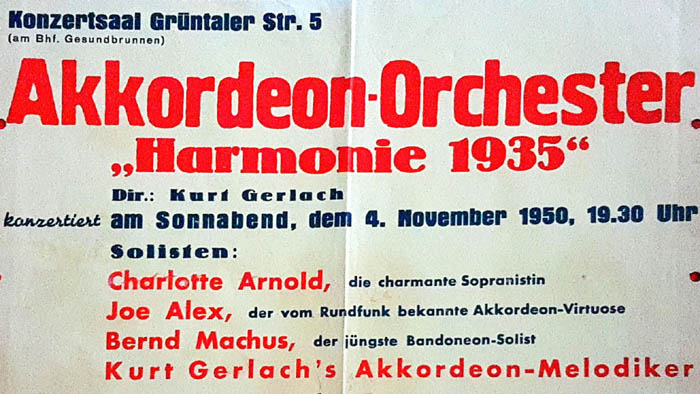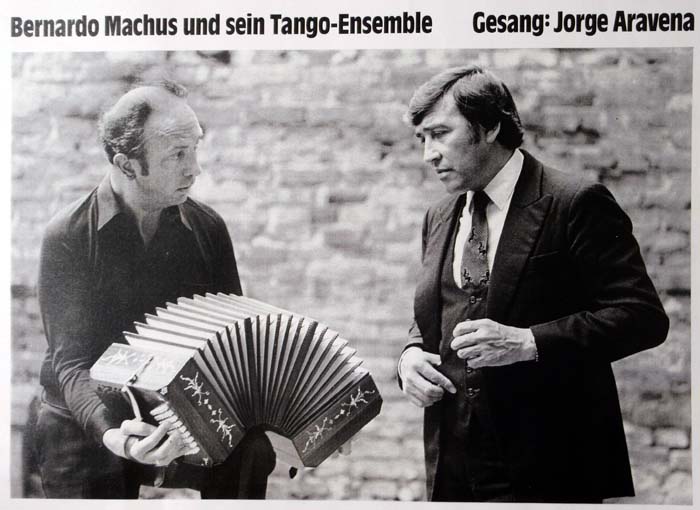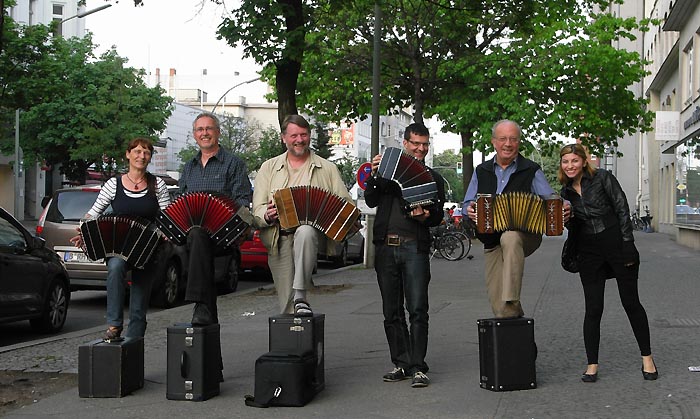A life with the Kusserow-Bandonion
Interview with musician Bernd Machus
Berlin, 24/2/2024
Mr Machus, I am delighted to be able to ask you a few questions about the Kusserow bandonion for bandonioninfo.de. Who better to answer them than you, who have been playing this unisonoric bandonion since 1948, i.e. for 76 years. Starting as a pupil with Ernst Kusserow himself, then as a professional musician for many years and later as a music teacher. So it's no exaggeration to say that the Kusserow bandonion has shaped your life. How did you find him?
Bernd Machus: I was nine years old at the time. Until then I had two years of lessons on the standard bass accordion and then I switched to Hugo Stark's Chromatiphon*. My accordion teacher had recommended it to my mum because this single-tone instrument would allow to do much more musically than the accordion. There were no single-tone accordions back then. My mum was immediately convinced and I started taking bandonion lessons on the Chromatiphon. After two years, however, my teacher died unexpectedly. My mother then tracked down Ernst Kusserow*, who was in great demand in Berlin. Ernst Kusserow, however, only took gifted students. My mother took me to his place to audition. He was just coming out of the basement with buckets of coal, while his master student Werner Böhm was warming up in his apartment. At the age of 19, Böhm was already a sought-after bandonion player for recordings at the radio station RIAS (Radio Im Amerikanischen Sektor) and elsewhere. After my foreplay, Böhm interceded that we needed offspring. Kusserow agreed to teach me, but only on the Kusserow bandonion, because he saw defects in the Chromatiphon. I then relearned on an Arnold instrument [ELA] that my father had bought for 1,000 East German or 500 West Marks. So, if anyone found the Kusserow for my life, it was my mother.

Who was Ernst Kusserow, whose name this bandionion bears?
B.M.: Ernst Kusserow was a very well-known Berlin music teacher and an active musician who also knew his way around bandonion building. In 1934, at the age of 37, he became the long-time leader of the bandonion class at the Stern Conservatory in Berlin. Throughout his life, he has been concerned about technical and qualitative improvements to the instrument. Shortly before his death in 1979, he was still working on an improvement design in his kitchen with simple tools. He always had high standards. For example, it had a 90-gram weight, which allowed it to check a keyboard for steady keystrokes. If a key did not sink under the weight, the button press was too high. It was often a problem that some buttons were harder to press than others, which is very much of a hindrance when gaming. He even took the weights with him to Arnold's [bandonion factory] in Carsfeld.
How long did you have lessons with Ernst Kusserow?
B.M: Until the state final examination at the University of Music. I was 21 at the time. He looked after me from A to Z the whole time, with intensive instrumental lessons, harmony, etc. until I sometimes went home crying as a child and my mother complained to him. He also strongly advised me and everyone else in the bandonion class to get a degree in pedagogy in order to be able to teach as a music teacher. He also put a lot of emphasis on my general education, and somehow took my life into his own hands. My time as a student at the Stern Conservatory and later at the University of Music was very profitable, also because you got some performances through student friends. In the bandonion class, for example, there were still Alfred Friedrich and Karl Oriwohl.
Have you come into contact with the once great club life of the Bandonion?
B.M.: With the Bandonion club life didn't anymore, but I was in the accordion orchestra of Kurt Gerlach, a very well-known man in Berlin at the time. As the only bandonion player, I was always available for the solo passages. But already at the age of eleven I performed as the "youngest bandonion soloist" in Berlin, where the well-known accordionist Joe Alex also played in the program. My mother and Ernst Kusserow always sat in the front row.

So you got a taste of the stage as a child?
B.M: Yes, and it went on smoothly. Later, as a young man and a sheet music eater, I played in East Berlin in a small entertainment revue with the small orchestra Schneidewind, or at afternoon tea in the Tierpark, etc. At that time, there were still plenty of opportunities for dance orchestras to perform. I also traveled through the GDR. Through the very good bandonionist Harry Schrader, I came at the age of 19 as a substitute for the Großes Tanzstreichorchester (Great Dance String Orchestra) Adalbert Lutter. After I shone with a demanding passage, in which Harry Schrader weakened on the bisonoric bandonion, I was considered set by Lutter. It's just the way it is, if the notes on the bisonoric Bandonion are bad, you break your fingers. However, this is not taken into account in an orchestra, but the key that sounds best is chosen. That was always the great advantage of the unisonoric Kusserow, that I could play everything that was presented to me without any problems. When I was 21, for example, I recorded Helmesberger's Ball scenes for the Dutch radio station Hilversum and was on the road with a band in the country. I also played jazz in American clubs for a long time.
 Many West Berlin musicians played in Adalbert Lutter's Großes Tanzstreichorchester like me, and it was, after all, the house orchestra of the East German radio station Berliner Rundfunk. Many West Berlin musicians made a living from the commissions of the East German broadcasters in Nalepa street and were employed there. The GDR stations Berliner Rundfunk and Deutschlandsender also had to offer their listeners something. The construction of the Berlin Wall in 1961 was therefore the end for some orchestras and many West Berlin musicians went stamping afterwards, because the Berlin music market had shrunk to West Berlin overnight for them in 1961. Personally, I had enough to do. Lots of recordings, e.g. at TELDEC, appearances with Heinrich Rietmüller*, the director of the RIAS Orchestra, as the house chapel of the most important television entertainer of this time, Hans Rosenthal. I also worked for Rietmüller on RIAS radio play recordings. Or at the SFB (Sender Freies Berlin) I was engaged as a guest musician by Paul Kuhn*, the leader of the SFB Big Band, for tango pieces and other performances.
Many West Berlin musicians played in Adalbert Lutter's Großes Tanzstreichorchester like me, and it was, after all, the house orchestra of the East German radio station Berliner Rundfunk. Many West Berlin musicians made a living from the commissions of the East German broadcasters in Nalepa street and were employed there. The GDR stations Berliner Rundfunk and Deutschlandsender also had to offer their listeners something. The construction of the Berlin Wall in 1961 was therefore the end for some orchestras and many West Berlin musicians went stamping afterwards, because the Berlin music market had shrunk to West Berlin overnight for them in 1961. Personally, I had enough to do. Lots of recordings, e.g. at TELDEC, appearances with Heinrich Rietmüller*, the director of the RIAS Orchestra, as the house chapel of the most important television entertainer of this time, Hans Rosenthal. I also worked for Rietmüller on RIAS radio play recordings. Or at the SFB (Sender Freies Berlin) I was engaged as a guest musician by Paul Kuhn*, the leader of the SFB Big Band, for tango pieces and other performances.

When did you notice a general decline in the bandonion in public?
B.M.: At the beginning of the 60s, this was not the case. It became a little less, but there were still enough players who played everywhere. Alfred Friedrich, for example, was a very well-known man here in Reinickendorf [District of Berlin]. People went there on Saturday or Sunday and listened. There was still music everywhere. Later, however, public music declined bit by bit.
What was your professional situation as a musician like during this time?
B.M: I always had a lot to do until the fall of the Berlin Wall. I played on balls on Wednesday, Friday, Saturday and Sunday. Then studio recordings e.g. with Udo Jürgens, Vicky Leandros and others. Berlin was a stronghold for record productions. But after reunification, the subsidies from the Berlin Funding ceased to exist. They all came to West Berlin because of the subsidies from the Berlin Funding. At that time, those who produced in West Berlin received financial support to keep the western part of the city alive. After that, there were only a few more recordings. And in public, canned music was on the rise. The dance orchestras were gradually disbanded. But since 1975 I had also worked as a teacher for piano and single-note accordion at a music school, of which I later became director. After that, I only gave bandonion courses, which were always attended by just under ten students. You also had to see where you could get Kusserow instruments. That was always a problem.
Do you have a musical role model among the bandonion players?
B.M.: Mosalini! Juan José Mosalini is my absolute role model. An excellent musician who plays incredibly cleanly. He has also written arrangements, such as harpsichord concertos for bandonion and flute. And, of course, Astor Piazzolla.
Which of your Kusserow bandonions impressed you the most?
B.M.: The one built by Klaus Gutjahr – a top-of-the-line instrument! The Gutjahr is by far the best of sound. Also how the keyboard runs. Klaus Gutjahr acquired the knowledge of bandonion building as an autodidact and really got down on his knees – with great sonic success. This has to be highly acknowledged. In 1983/85 he had also built a series of five Kusserows. After that, however, he didn't want to know anything more because of the elaborate sheet metal bending of Kusserows. Unfortunately, he even rejected the possibility of expelling Kusserows via Hohner.

Around 2005, Peter Spende* again built a few Kusserows in Berlin. Were there any innovations in them?
B.M.: Absolutely! Peter Spende started as a career changer at Klaus Gutjahr and founded a joint company with him in 1995. After some time, however, both went their own ways and continued to build bisonoric instruments separately. At my suggestion, Peter Spende was open to building unisonoric Kusserows. But only if he can design a mechanism free of large sheet metal bending. With the expertise of his former profession as a design engineer, he has succeeded very well in this. In doing so, he has virtually redeveloped Hugo Starke's reform keyboard*. With a few more improvements that I have been able to contribute thanks to my long use of the instrument, the Kusserow built by Peter Spende is a much improved model. It should definitely be used as a basis for new editions. Unfortunately, there are no more construction documents available, so that a new measurement would have to be made.
How did your 76-year practical test with the Kusserow go? Has it ever let you down, in the sense that a part was only very difficult or not playable at all due to the keyboard system?
B.M.: It's optimal. I've been playing in the recording field for many years now, recordings, film recordings, etc. And sometimes heavy things were put in front of me. You might be able to practice for a short time, but there was never much time for it. At the orchestra appointments, the producer handed out the notes, you could look through them briefly and play them, but then the conductor came: "So let's play through this now." Then they played through it three or four times and then the recording was made. You don't have time to prepare the piece according to the most favorable bellows direction, because you play an bisonoric instrument. You also have to be able to play on demand in the same quality in every key. With Udo Jürgens [a German pop singer], I had a title that was in C major and then, unusually, changed to C sharp major with seven sharps, a very rarely played key. But on the Kusserow I slide down a semitone, a button, with my right hand and can play it immediately. Or Fred Oldörp from the 3 Travellers called me: 'You have to save me. Heinz Alisch has arranged a title in D flat major for his orchestra, but I can't get it right.' This is a difficult key to grasp on the bisonoric instrument, but no problem with the Kusserow.
What's the problem with bisonoric instruments in such situations?
B.M.: On the bisonoric bandonion, some keys, especially B flat keys, are difficult to grasp because of the tone assignment, because the bisonoric keyboard system was built and extended primarily for major keys. Difficult keys are therefore avoided and it is preferable to play in more favourable keys. However, an arranger does not take this into account. There is no such difference at Kusserow. All keys can be played in the same way. On the bisonoric bandonion you also have to pay attention to the time of the change of the bellows direction in order to change to the most favorable grip positions possible. This is completely irrelevant on the unisonoric Kusserow, because the fingering is the same for each bellows direction. That is the meaning and advantage of the unisonoric principle. My only positive experiences have also been confirmed to me by Werner Böhm, the already mentioned master student of Ernst Kusserow. Böhm was a permanent member of the RIAS as a studio musician, he didn't do anything else. There he was constantly presented with a wide variety of arrangements for the RIAS Ensemble Adolf Wrege and the RIAS Tanzorchester and it was all playable without any problems. He never had any problems with the Kusserow bandonion that would have limited him in terms of play. And it was the same with me.
What is the state of the Kusserow Bandonion today, seven decades after your first notes on this instrument?
B.M.: Well, the bandonion generally leads a shadowy existence, regardless of the type of construction. Over the years, there have always been almost ten participants in my course, which I consider a success. The main problem, however, is the lack of Kusserow instruments. When someone registers, they often have to organize an instrument first. So if 20 people were to sign up, there would be no Kusserows for them, neither at school nor in the instrument trade. That's why Peter Spende is so valuable with his improved small series from 2005, because there are now satisfying prototypes with these instruments that someone could use to build more. It would also be worth considering a smaller Kusserow Concertina for children, so that not only adults can play with the Kusserow system. By the way, there is a school for Kusserow-Bandonion written by me, which is available in German, English and Spanish on my site www.berndmachus.de.

Thank you very much for the interesting retrospectives into the musical events of earlier times and the information about the instrument! I wish you continued 'Gut Ton'! (An old german bandonion salute.)
Playing instructions for Kusserow bandonion by Bernd Machus (video)
* Ernst Kusserow (1897-1979)
* Heinrich Riethmüller, conductor of the RIAS orchestra a.o. (German)
* Paul Kuhn, conductor of the SFB Big Band a.o. (German)
* Kusserow-Bandonion from Peter Spende